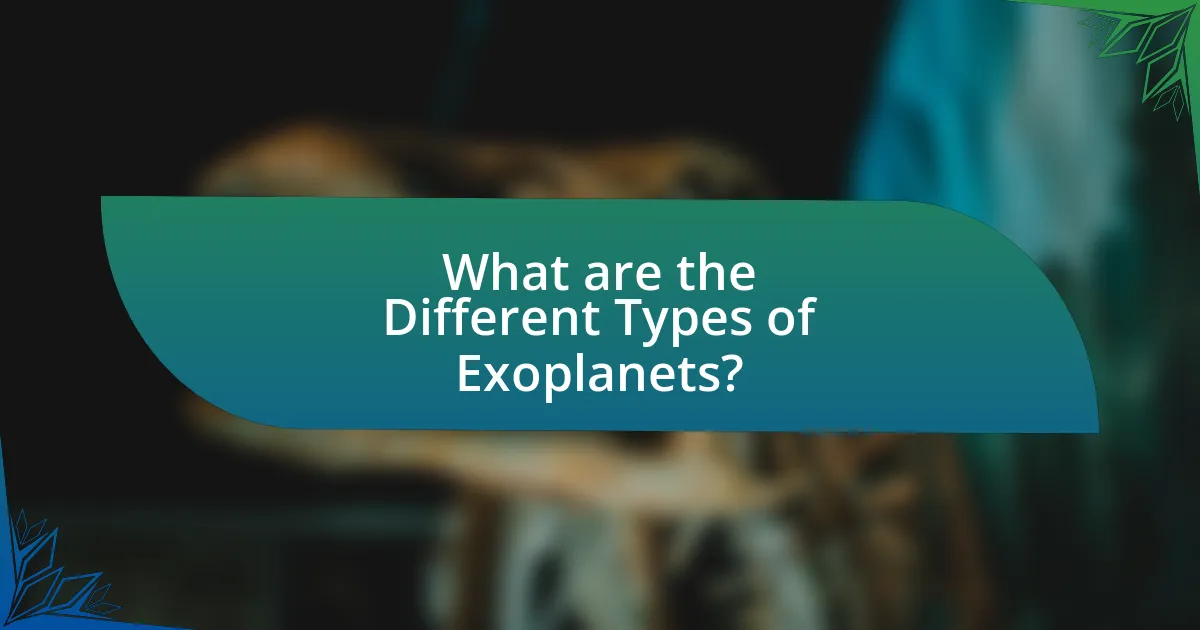Exoplanets are planets that orbit stars outside our solar system, and as of October 2023, over 5,000 have been confirmed. This article explores the definition and classification of exoplanets, the methods used for their discovery, and their significance in understanding planetary systems and the potential for extraterrestrial life. It discusses various types of exoplanets, notable discoveries, and the challenges faced in exoplanet research, including limitations of current detection methods and the analysis of exoplanet atmospheres. The article also highlights future prospects for exoplanet exploration and the implications of this research for planetary science and the search for life beyond Earth.

What are Exoplanets and Why are They Important?
Exoplanets are planets that orbit stars outside our solar system. They are important because they expand our understanding of planetary systems and the potential for life beyond Earth. As of October 2023, over 5,000 exoplanets have been confirmed, revealing a diverse range of sizes, compositions, and orbital characteristics. The study of exoplanets helps scientists investigate the conditions necessary for life, assess the habitability of other worlds, and refine models of planetary formation and evolution. This research is crucial for answering fundamental questions about our place in the universe and the possibility of discovering extraterrestrial life.
How do we define an exoplanet?
An exoplanet is defined as a planet that orbits a star outside of our solar system. This definition encompasses a wide variety of celestial bodies, including those that may be similar to Earth or vastly different. As of October 2023, thousands of exoplanets have been confirmed through methods such as the transit method and radial velocity, demonstrating their existence and diversity in size, composition, and orbital characteristics.
What criteria classify a celestial body as an exoplanet?
A celestial body is classified as an exoplanet if it orbits a star outside our solar system and has sufficient mass for its self-gravity to overcome rigid body forces, resulting in a nearly round shape. Specifically, exoplanets must not be massive enough to initiate nuclear fusion, which distinguishes them from stars. The International Astronomical Union (IAU) defines exoplanets as planets that orbit stars other than the Sun, emphasizing their location and characteristics. This classification is supported by discoveries made through methods such as the transit method and radial velocity measurements, which have identified thousands of exoplanets since the first confirmed detection in 1992.
Why is the study of exoplanets significant in astronomy?
The study of exoplanets is significant in astronomy because it enhances our understanding of planetary systems beyond our own, revealing the diversity and characteristics of worlds that may harbor life. Research has shown that over 5,000 exoplanets have been confirmed, with various methods such as the transit method and radial velocity providing insights into their atmospheres, compositions, and potential habitability. This exploration not only informs theories about the formation and evolution of planets but also aids in the search for extraterrestrial life, as scientists can identify Earth-like conditions in distant systems.
What methods are used to discover exoplanets?
The primary methods used to discover exoplanets include the transit method, radial velocity method, direct imaging, and gravitational microlensing. The transit method detects exoplanets by observing the dimming of a star’s light as a planet passes in front of it, which has been successfully employed by missions like Kepler and TESS. The radial velocity method measures variations in a star’s spectrum due to the gravitational pull of an orbiting planet, providing insights into the planet’s mass and orbit. Direct imaging captures images of exoplanets by blocking out the star’s light, allowing for the study of their atmospheres and compositions. Gravitational microlensing occurs when a massive object, like a star, magnifies the light of a more distant star, revealing the presence of a planet. Each of these methods has contributed significantly to the growing catalog of known exoplanets, with thousands confirmed to date.
How does the transit method work in exoplanet detection?
The transit method detects exoplanets by observing the periodic dimming of a star’s light as a planet passes in front of it. This dimming occurs because the planet blocks a fraction of the star’s light, leading to a measurable decrease in brightness. The Kepler Space Telescope, which operated from 2009 to 2018, utilized this method to identify thousands of exoplanets by monitoring the brightness of over 150,000 stars for transits, confirming the effectiveness of this technique in exoplanet detection.
What role does radial velocity play in finding exoplanets?
Radial velocity is crucial in finding exoplanets as it measures the changes in a star’s position due to the gravitational pull of an orbiting planet. This technique detects the Doppler shift in the star’s spectral lines, indicating whether the star is moving towards or away from Earth. For instance, the first confirmed exoplanet, 51 Pegasi b, was discovered using radial velocity measurements, which revealed the star’s periodic motion caused by the planet’s gravitational influence. This method has led to the discovery of thousands of exoplanets, demonstrating its effectiveness in identifying planets outside our solar system.

What are the Different Types of Exoplanets?
Exoplanets can be categorized into several types based on their characteristics and orbital properties. The main types include terrestrial planets, which are rocky and similar to Earth; gas giants, which are large and composed mainly of hydrogen and helium; ice giants, which have a significant amount of water, ammonia, or methane ice; and super-Earths, which are larger than Earth but smaller than gas giants. Additionally, there are hot Jupiters, which are gas giants that orbit very close to their stars, and mini-Neptunes, which are smaller than Neptune but larger than Earth. These classifications are supported by discoveries made through various methods, including transit photometry and radial velocity measurements, revealing the diversity of planetary systems beyond our own.
How are exoplanets categorized based on their characteristics?
Exoplanets are categorized based on their characteristics into several types, primarily including terrestrial, gas giants, ice giants, and super-Earths. Terrestrial exoplanets, like Earth and Mars, are rocky and have solid surfaces. Gas giants, such as Jupiter and Saturn, are predominantly composed of hydrogen and helium and lack a well-defined solid surface. Ice giants, including Uranus and Neptune, have a composition that includes water, ammonia, and methane ices. Super-Earths are larger than Earth but smaller than gas giants, often having rocky compositions and potential atmospheres. This classification is supported by observational data from missions like Kepler and TESS, which have identified thousands of exoplanets and provided insights into their physical and chemical properties.
What distinguishes terrestrial planets from gas giants?
Terrestrial planets are distinguished from gas giants primarily by their solid, rocky surfaces and smaller sizes. Terrestrial planets, such as Earth and Mars, have a composition that includes metals and silicate rocks, while gas giants, like Jupiter and Saturn, are predominantly composed of hydrogen and helium, lacking a well-defined solid surface. This difference in composition and structure leads to variations in atmospheric conditions, density, and the presence of geological features. For instance, terrestrial planets have higher densities and can support solid landforms, whereas gas giants have thick atmospheres and may possess deep layers of liquid or gaseous materials beneath their outer clouds.
What are super-Earths and mini-Neptunes?
Super-Earths and mini-Neptunes are types of exoplanets that differ primarily in their size and composition. Super-Earths are rocky planets with a mass larger than Earth’s but significantly less than that of Neptune, typically ranging from 1 to 4 times Earth’s mass. Mini-Neptunes, on the other hand, are gaseous planets that have a mass between 2 and 10 times that of Earth, characterized by a thick atmosphere and potentially a small rocky core. The distinction between these two types is crucial for understanding planetary formation and the potential for habitability, as evidenced by the discovery of numerous super-Earths and mini-Neptunes in the habitable zones of their stars, which suggests diverse planetary systems exist beyond our own.
What are the most notable exoplanets discovered so far?
The most notable exoplanets discovered so far include Kepler-186f, Proxima Centauri b, and TRAPPIST-1e. Kepler-186f, identified by NASA’s Kepler mission, is significant as it is the first Earth-sized exoplanet found in the habitable zone of another star, which is crucial for the potential of life. Proxima Centauri b orbits the closest star to the Sun and lies within its habitable zone, making it a prime candidate for further study regarding extraterrestrial life. TRAPPIST-1e is part of a system with seven Earth-sized planets, three of which are in the habitable zone, highlighting the diversity and potential for habitability in exoplanetary systems. These discoveries are backed by data from missions such as Kepler and the European Southern Observatory, confirming their existence and characteristics.
Which exoplanets are considered potentially habitable?
Exoplanets considered potentially habitable include Proxima Centauri b, Kepler-186f, and TRAPPIST-1e. Proxima Centauri b orbits within the habitable zone of its star, allowing for the possibility of liquid water. Kepler-186f is notable for being the first Earth-sized exoplanet found in the habitable zone of another star, which suggests conditions suitable for life. TRAPPIST-1e is part of a system with multiple Earth-sized planets in the habitable zone, increasing the likelihood of finding life-supporting environments. These classifications are based on their distance from their stars, size, and potential for liquid water, which are critical factors for habitability.
What unique features do some exoplanets exhibit?
Some exoplanets exhibit unique features such as extreme temperatures, unusual atmospheric compositions, and unique orbital characteristics. For instance, the exoplanet WASP-121b has a temperature exceeding 4,000 degrees Fahrenheit, making it one of the hottest known exoplanets. Additionally, exoplanets like HD 189733b possess atmospheres rich in silicate clouds, which can create glass rain due to high wind speeds. Furthermore, the orbital eccentricity of exoplanets like 55 Cancri e, which has a highly elliptical orbit, leads to significant variations in temperature and atmospheric pressure. These distinctive traits highlight the diversity of planetary systems beyond our own.

What Challenges Do Scientists Face in Exoplanet Research?
Scientists face several challenges in exoplanet research, primarily related to detection, characterization, and data interpretation. The vast distances to exoplanets make them difficult to observe directly, often requiring advanced techniques like transit photometry or radial velocity measurements. For instance, the Kepler Space Telescope identified over 2,300 confirmed exoplanets, but many of these detections are indirect, leading to uncertainties in their actual properties. Additionally, distinguishing between signals from exoplanets and noise from stars or other celestial phenomena complicates data analysis. The limited spectral data available for many exoplanets also hinders scientists’ ability to assess their atmospheres and potential habitability. These challenges necessitate ongoing advancements in technology and methodology to improve the accuracy and reliability of exoplanet research.
What are the limitations of current exoplanet detection methods?
Current exoplanet detection methods face several limitations, primarily including sensitivity, bias, and the inability to characterize atmospheres. Sensitivity issues arise because many detection techniques, such as the transit method and radial velocity method, can only identify large planets close to their stars, missing smaller, Earth-like planets in wider orbits. Bias is another limitation, as these methods tend to favor certain types of planets, leading to an incomplete understanding of the diversity of exoplanets. Additionally, current methods struggle to analyze the atmospheres of detected exoplanets, which is crucial for assessing their habitability. For instance, the Kepler Space Telescope primarily detected large gas giants, with only a small fraction of its findings being potentially habitable Earth-sized planets.
How does distance from Earth affect our ability to study exoplanets?
Distance from Earth significantly limits our ability to study exoplanets, as greater distances reduce the amount of light and data we can collect. For instance, exoplanets located hundreds of light-years away emit faint signals that are difficult to detect with current telescopes, which typically have a limited sensitivity range. The Kepler Space Telescope, which discovered thousands of exoplanets, primarily focused on stars within a few thousand light-years, demonstrating that proximity enhances the likelihood of successful observation. Additionally, the Doppler effect and transit methods used to study exoplanets become less effective as distance increases, making it challenging to gather accurate data on their atmospheres and compositions.
What technological advancements are needed for better detection?
Advanced telescopes with improved sensitivity and resolution are essential for better detection of exoplanets. These telescopes, such as the James Webb Space Telescope, utilize infrared technology to observe distant celestial bodies more effectively. Enhanced data processing algorithms, including machine learning techniques, can analyze vast amounts of data from these observations, identifying potential exoplanets with greater accuracy. Furthermore, the development of space-based observatories reduces atmospheric interference, allowing for clearer imaging of exoplanets. These advancements collectively contribute to a more precise understanding of exoplanet characteristics and their potential habitability.
How do we analyze the atmospheres of exoplanets?
We analyze the atmospheres of exoplanets primarily through spectroscopy, which involves studying the light that passes through or is emitted by an exoplanet’s atmosphere. When a planet transits in front of its host star, some of the star’s light filters through the planet’s atmosphere, causing specific wavelengths of light to be absorbed by atmospheric gases. This absorption creates a unique spectral fingerprint that can be detected by telescopes.
For instance, the Hubble Space Telescope has successfully identified the presence of water vapor in the atmospheres of several exoplanets by analyzing their transmission spectra. This method allows scientists to determine the composition, temperature, and even weather patterns of these distant worlds, providing critical insights into their potential habitability.
What techniques are used to study exoplanet atmospheres?
Techniques used to study exoplanet atmospheres include transmission spectroscopy, emission spectroscopy, and direct imaging. Transmission spectroscopy analyzes the light that passes through an exoplanet’s atmosphere during a transit, allowing scientists to identify chemical signatures. Emission spectroscopy measures the light emitted by an exoplanet’s atmosphere, providing insights into its temperature and composition. Direct imaging captures the light from an exoplanet itself, enabling the study of its atmospheric characteristics. These methods have been validated through observations from telescopes such as the Hubble Space Telescope and the upcoming James Webb Space Telescope, which enhance our understanding of exoplanetary atmospheres.
What challenges arise in interpreting atmospheric data?
Interpreting atmospheric data presents several challenges, primarily due to the complexity of atmospheric processes and the limitations of current observational techniques. The variability in atmospheric composition, temperature, and pressure can lead to ambiguous interpretations of data collected from exoplanets. For instance, the presence of multiple gases can complicate the identification of specific atmospheric constituents, as overlapping spectral signatures may obscure individual signals. Additionally, the distance of exoplanets from Earth limits the resolution of data, making it difficult to obtain precise measurements. Studies, such as those conducted by the Hubble Space Telescope, have shown that even slight variations in light can significantly affect the interpretation of atmospheric conditions, highlighting the need for advanced models and techniques to accurately analyze the data.
What are the future prospects for exoplanet exploration?
The future prospects for exoplanet exploration are highly promising, driven by advancements in technology and increased investment in space missions. Upcoming missions, such as NASA’s James Webb Space Telescope, are expected to provide unprecedented data on exoplanet atmospheres, potentially identifying biosignatures. Additionally, the European Space Agency’s Ariel mission, set to launch in 2029, aims to study the chemical compositions of exoplanet atmospheres, enhancing our understanding of their habitability. The growing number of ground-based observatories and space telescopes will further facilitate the discovery and characterization of exoplanets, with estimates suggesting that thousands more could be identified in the coming decade. These developments indicate a significant expansion in our knowledge of alien worlds and their potential for supporting life.
How will upcoming missions enhance our understanding of exoplanets?
Upcoming missions will enhance our understanding of exoplanets by utilizing advanced technologies to gather more precise data on their atmospheres, compositions, and potential habitability. For instance, the James Webb Space Telescope, launching in December 2021, is designed to analyze the atmospheres of exoplanets through spectroscopy, allowing scientists to detect chemical signatures indicative of life. Additionally, missions like the European Space Agency’s ARIEL, set to launch in 2029, will focus on characterizing the atmospheres of a wide range of exoplanets, providing insights into their formation and evolution. These missions will significantly increase the number of known exoplanets with detailed atmospheric data, thereby deepening our understanding of their potential for supporting life.
What role do space telescopes play in future discoveries?
Space telescopes are crucial for future discoveries as they provide unprecedented views of distant celestial objects, enabling the detection and analysis of exoplanets. For instance, the James Webb Space Telescope, launched in December 2021, is designed to observe the atmospheres of exoplanets, allowing scientists to identify chemical signatures indicative of habitability or potential life. This capability is supported by its advanced infrared technology, which can penetrate cosmic dust and reveal hidden details about planetary systems. Such observations are essential for expanding our understanding of the universe and the potential for life beyond Earth.
What can we learn from studying exoplanets?
Studying exoplanets allows us to understand the diversity of planetary systems and the potential for life beyond Earth. By analyzing their atmospheres, compositions, and orbits, scientists can infer the conditions that may support life, as demonstrated by the discovery of potentially habitable zones around stars. For instance, the Kepler Space Telescope has identified thousands of exoplanets, revealing that many are Earth-sized and located in their star’s habitable zone, where liquid water could exist. This data enhances our knowledge of planetary formation and evolution, providing insights into how common or rare Earth-like planets may be in the universe.
How does exoplanet research contribute to our understanding of life beyond Earth?
Exoplanet research enhances our understanding of life beyond Earth by identifying potentially habitable environments and analyzing the atmospheric conditions of these distant worlds. The discovery of exoplanets within the habitable zone, where conditions may allow for liquid water, suggests that similar life-supporting environments could exist elsewhere in the universe. For instance, the Kepler Space Telescope has identified thousands of exoplanets, with several located in their star’s habitable zone, indicating the possibility of life. Additionally, studying the atmospheres of these exoplanets through techniques like transit spectroscopy reveals the presence of key molecules, such as water vapor and carbon dioxide, which are essential for life as we know it. This data supports the hypothesis that life could exist on planets with similar characteristics to Earth.
What implications does exoplanet research have for planetary science?
Exoplanet research significantly enhances planetary science by providing insights into planetary formation, evolution, and the potential for life beyond Earth. The discovery of diverse exoplanetary systems challenges existing models of planetary formation, suggesting that processes may be more complex than previously understood. For instance, the Kepler Space Telescope has identified thousands of exoplanets, revealing a wide variety of sizes and orbital characteristics, which informs theories about how planets form and migrate within their systems. Additionally, studying the atmospheres of exoplanets through techniques like transit spectroscopy allows scientists to assess their composition and potential habitability, thereby expanding our understanding of the conditions necessary for life. This research not only deepens knowledge of our own solar system but also informs the search for extraterrestrial life, making it a crucial aspect of modern planetary science.
What practical steps can enthusiasts take to engage with exoplanet research?
Enthusiasts can engage with exoplanet research by participating in citizen science projects, such as those offered by NASA’s Planet Hunters or the Zooniverse platform, which allow individuals to analyze data from telescopes and contribute to the discovery of new exoplanets. These platforms provide access to real astronomical data, enabling participants to help identify potential exoplanet transits. Additionally, enthusiasts can join local astronomy clubs or online forums to collaborate with others, share findings, and stay updated on the latest research. Engaging with educational resources, such as online courses or webinars focused on exoplanet science, further enhances understanding and involvement in the field.




